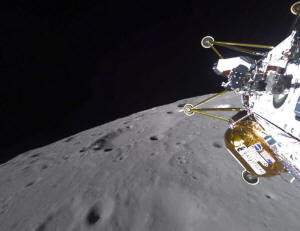Private lunar lander may have fallen over while touching down near the
moon's south pole
[March 07, 2025]
By MARCIA DUNN
CAPE CANAVERAL, Fla. (AP) — A privately owned lunar lander touched down
on the moon with a drill, drone and rovers for NASA and other customers
Thursday, but quickly ran into trouble and may have fallen over.
Intuitive Machines said it was uncertain whether its Athena lander was
upright near the moon’s south pole — standing 15 feet (4.7 meters) tall
— or lying sideways like its first spacecraft from a year ago.
Controllers rushed to turn off some of the lander’s equipment to
conserve power while trying to determine what went wrong.
It was the second moon landing this week by a Texas company under NASA’s
commercial lunar delivery program. Sunday’s touchdown was a complete
success.
Intuitive Machines' newest Athena lander dropped out of lunar orbit as
planned. The hourlong descent appeared to go well until the final
approach when the laser navigation system began acting up. It took a
while for Mission Control to confirm touchdown.
“We're on the surface,” reported mission director and co-founder Tim
Crain. A few minutes later, he repeated, "It looks like we're down ...
We are working to evaluate exactly what our orientation is on the
surface.”
Hours after the landing, Intuitive Machines CEO Steve Altemus there was
conflicting data about how Athena landed and whether it was on its side.
The lander was near the intended target site, but a sweep by NASA's
Lunar Reconnaissance Orbiter in the coming days will confirm its
position and orientation, he said.

Launched last week, Athena was communicating with controllers more than
230,000 miles (375,000 kilometers) away and generating solar power,
officials said. Mission managers worked to salvage the mission to see
whether the drill can be turned on and the drone can be deployed to hop
into a crater.
“Obviously, without knowing the exact orientation of the lander, it’s
hard to say exactly what science we will and will not be able to do,"
said NASA's top science officer Nicky Fox.
Intuitive Machines last year put the U.S. back on the moon despite its
lander tipping on its side.
On Sunday, Firefly Aerospace became the first private entity to achieve
complete success with its Blue Ghost lunar lander, on the northeastern
edge of the near side of the moon. A vacuum already has collected lunar
dirt for analysis and a dust shield has shaken off the abrasive
particles that cling to everything.

[to top of second column]
|

This photo provided by NASA shows the Intuitive Machines' Athena
lander approaching the surface of the moon on Thursday, March 6,
2025. (NASA via AP)

Intuitive Machines was aiming this time for a mountain plateau just
100 miles (160 kilometers) from the south pole, much closer than
before. It reached the plateau, but Intuitive Machines was not sure
how near it was to the precise targeted spot.
This week's back-to-back moon landings are part of NASA’s commercial
lunar delivery program meant to get the space agency’s experiments
to the gray, dusty surface and jumpstart business. The commercial
landers are also seen as scouts for the astronauts who will follow
later this decade under NASA's Artemis program, the successor to
Apollo.
NASA officials said before the landing that they knew going in that
some of the low-cost missions would fail. But with more private
missions to the moon, that increased the number of experiments
getting there.
NASA spent tens of millions of dollars on the ice drill and two
other instruments riding on Athena, and paid an additional $62
million for the lift. Most of the experiments were from private
companies, including the two rovers. The rocket-powered drone came
from Intuitive Machines — it's meant to hop into a permanently
shadowed crater near the landing site in search of frozen water.
To lower costs even more, Intuitive Machines shared its SpaceX
rocket launch with three spacecraft that went their separate ways.
Two of them — NASA’s Lunar Trailblazer and AstroForge’s
asteroid-chasing Odin — are in jeopardy.
NASA said this week that Lunar Trailblazer is spinning without radio
contact and won’t reach its intended orbit around the moon for
science observations. Odin is also silent, with its planned asteroid
flyby unlikely.
As for Athena, Intuitive Machines made dozens of repairs and
upgrades following the company’s sideways touchdown by its first
lander. It still managed to operate briefly, ending America’s
moon-landing drought of more than 50 years.
Until then, the U.S. had not landed on the moon since Apollo 17 in
1972. No one else has sent astronauts to the moon, the overriding
goal of NASA’s Artemis program. And only four other countries have
successfully landed robotic spacecraft on the moon: Russia, China,
India and Japan.
All contents © copyright 2025 Associated Press. All rights reserved |